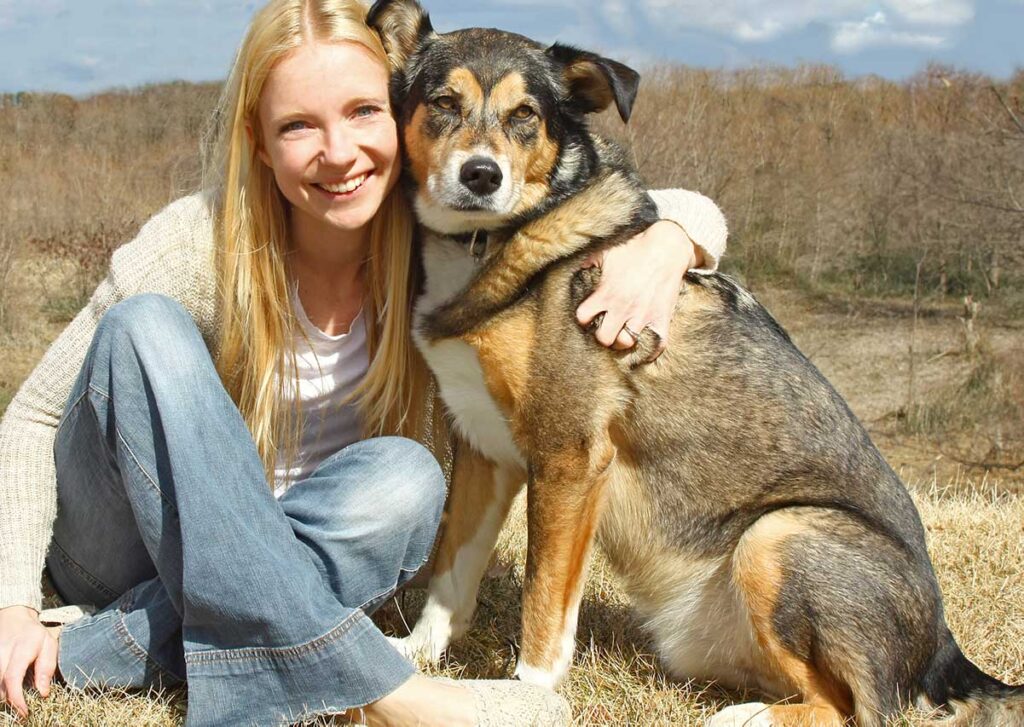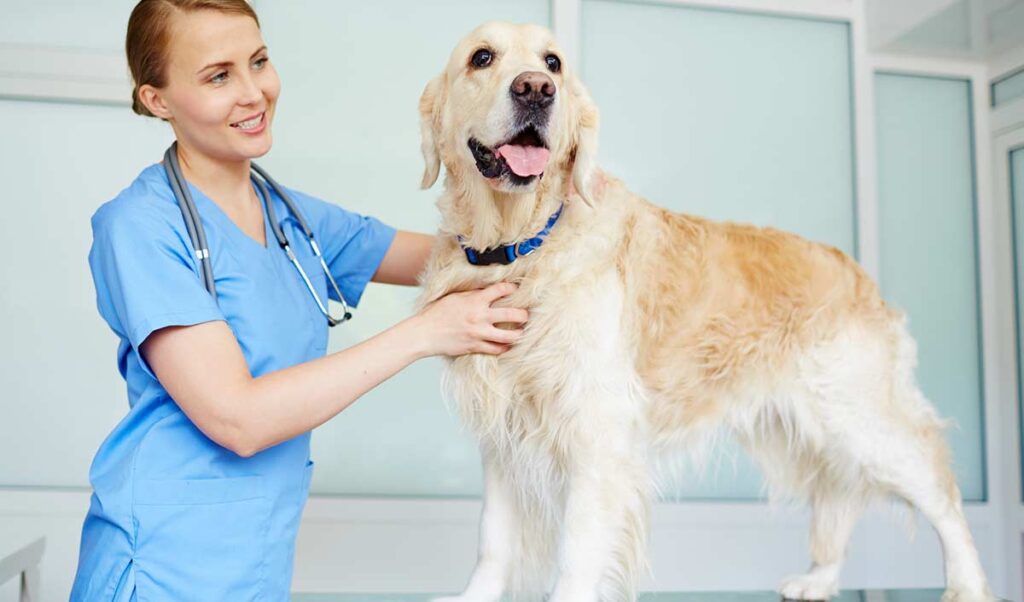This article was updated on December 18th, 2023

Just like people, dogs can develop dementia as they grow older. It goes by a lot of names, including Canine Cognitive Dysfunction (CCD) and ‘Old Dog Syndrome’, but the symptoms always resemble Alzheimer’s in humans. It’s also very common in senior dogs: studies show that around 50% of dogs who are eight years old or older show some signs of Canine Cognitive Dysfunction.
In our clinic, owners often ask us if concerning changes in their older dog’s behavior are just symptoms of ‘old age’ or if there’s an underlying health worry. In this article, I will discuss 7 important things you should know about ‘Old Dog Syndrome’ and tips to help your dog. Let’s get started!
7 Things to Know About Old Dog Syndrome / Dementia in Dogs
1. Symptoms can range from minimal to severe enough to cause real disruption
“Old Dog Syndrome can be mild enough that the symptoms are minimal, or severe enough to cause real disruption to your life, and your dog’s life.”
Symptoms can be divided into two categories, physical and emotional/psychological.
Common physical changes that could indicate old dog syndrome:
- Changes in sleep patterns
- Loss of bladder, or bowel, control
- Apparent loss of hearing or poor vision
- Excessive shaking, trembling or panting
- Loss of appetite, general disinterest in food
- Seems to get ‘lost’ easily, even at home in rooms he’s familiar with
- ‘Blank’ periods – sitting and staring into space, or ‘checking-out’
- Restless roaming, pacing or circling
- Hiding or ‘nesting’ behavior
- Impulsive, uncharacteristic behavior
Emotional/psychological/behavioral changes:
- Disorientation/confusion
- Less affectionate and social
- Forgetfulness
- Anxiety & fearfulness
- Nightmares or night terrors
- Personality changes
- Separation anxiety
2. Every dog shows different symptoms & diagnosis can be challenging
Usually, you diagnose a health problem by looking at the symptoms, and this is true with CCD (Old Dog Syndrome) too… but it’s not as easy as diagnosing a broken leg or an upset tummy.
“Every dog is unique and might show a different set of symptoms, or experience them to a greater, or lesser, degree. So, it’s easy to see the problems facing owners and veterinarians to diagnose this disease. There isn’t one definitive blood test or diagnostic procedure that can diagnose canine cognitive dysfunction. There are a lot of different symptoms that might mean Fido has CCD, but many of them can also be signs of other health problems, too.”
Researchers have found subtle changes in the brains of dogs with Old Dog Syndrome, similar to the changes that happen in the brains of human Alzheimer’s patients. But brain scans or other procedures aren’t considered to be useful at this point, and so, they aren’t available for CCD testing.
Your veterinarian makes a diagnosis of Canine Cognitive Dysfunction in two steps…
1. First, they rule out any other possible health conditions.
2. Second, they assess the number and severity of Fido’s symptoms for dementia.
So, if your senior dog is showing one, or more, of the symptoms listed on this page, then it is vital to get him a full health check-up to rule out other underlying diseases that could be causing these symptoms.
Although CCD is incurable, the sooner you get a diagnosis, the sooner you can start doing things at home to help Fido feel better and ease the problems that come along with this condition.
3. Feed your dog an antioxidant-rich diet and supplements.
Antioxidants, vitamins, and minerals can help protect Fido’s brain cells from further damage. It’s important to feed him/her a dog food that’s rich in antioxidants. Certain supplements can also help reduce the problems associated with CCD. Some herbs might also be helpful, such as Lemon Balm and Gingko.
“Always make sure you’re choosing premium quality food/supplements and avoid artificial additives and chemicals. Also, dogs with CDD sometimes lose interest in food, or ‘forget’ to eat, so you’ll need to make sure that Fido actually eats his antioxidant rich food.”
Supplements can be given in tasty treats – most dogs of any age rarely turn down a yummy! Here are a few that may benefit your dog with dementia:
> Omega-3
Omega-3 fatty acids reduce inflammation, improve circulation, and lower blood pressure, all of which help to keep those brain cells healthy. This means that Fido should find it easier to learn new things or remember new or old habits and lessons. See this listing on Amazon:
- WHY OMEGA-3 PET - This Nordic Naturals pet product is made with the same exceptional quality oil as our human products, but has been specially formulated for your dog. Omega-3 Pet features omega-3 fish oil in soft gels.
> Coconut Oil
Fruit and vegetables are good for reducing inflammation, and adding organic, cold-pressed coconut oil to his food daily is beneficial for many functions, including the brain.
- PREMIUM INGREDIENTS: Our pure, unrefined extra-virgin coconut oil for dogs is cold pressed to better preserve its nutrients and is a rich source of essential fatty acids; made in the USA from plantation-fresh coconuts, this dog-safe coconut oil supplement is perfect for puppies to senior animals and tastes and smells great
There are no specific dosage recommendations for adding coconut oil to your dog’s diet, but most veterinarians recommend that you start with what’s considered to be a low dose and work up from there.
This could mean starting at 1/4 tsp of coconut oil per 10lbs of body weight and gradually increasing that up to a maximum of 1 tsp per 10lbs.
> Choline Supplements
There is a range of different nutritional supplements which claim to help dogs with age-related cognitive decline. Generally, they contain ingredients which can help promote healthy neurological function and protect neurotransmitters (as well as having positive effects on other parts of the body).
Supplements containing choline are often recommended by veterinarians to help manage Old Dog Syndrome, and may also play a role in prevention.
Choline is an essential nutrient that has benefits for not just the brain, but also helps maintain healthy liver function, lung function, metabolism and more.
It’s also often suggested to aid in the management of seizures, diabetes and adrenal disease.
There are very few side effects of giving choline (often found as Phosphatidylcholine in supplements) to dogs.
Sometimes a dog can become extra excitable or nervous/hyper/anxious. If this happens, reducing the dose might help. If it doesn’t, then choline is probably not suitable for him/her.
Your veterinarian will be able to aid in determining the ideal dosage of choline for your dog. Alternatively, ensure you follow the dosage guidelines accurately on the packaging of the health supplement.
Here is an option below from Amazon if you’d like to try choline for your golden oldie:
- It is a significant dietary factor in preventing fatty-liver syndrome in diabetic dogs
> A Few Others
Phosphatidylserine has been shown to help improve memory function and understanding, and is found in products such as Senilife and Thorne Canine Geriatric Basics.
Adenosyl maintains good overall brain health and can also improve the quality of sleep and support memory function. It can be found in the Nutramax Denosyl chewables and the S-adenosyl (SAMe) tablets.
Neutricks Soft Chews contain Apoaequorin which appears to improve memory, cognition, and performance in dogs with cognitive dysfunction.
Supplements may not help all dogs, but as they don’t pose any health risks when used properly in my opinion it’s worth checking some out.
Learn more or purchase these supplements by clicking on the product links below:
If sleep is a problem for your older dog (i.e. he doesn’t sleep enough, wakes up too often or is restless at night), products containing melatonin may help.
Natural products that have a calming or sedative effect (such as Bach Flower Remedies or even pheromone diffusers) might be helpful, too.
4. Exercise both your dog’s brain and body.

In humans, research shows that elderly people who are socially isolated and whose brains are under-stimulated are up to 68% more likely to develop Alzheimer’s, or dementia.

It seems that the same might be true of dogs.
Several studies and ongoing research show that when Fido’s brain (and body) is exercised, his learning (or cognitive) ability improves.
This might be due to the increased blood flow through major organs, including the brain, that comes with exercise.
Older dogs sometimes want to sleep all the time, especially those with Old Dog Syndrome, but they need some daily exercise.
And don’t discount the social benefits of getting out-and-about. Spending some time with his doggie friends might be just what the doctor ordered.
“Depending on your older dog’s general health, ‘exercise’ might not be more than a slow amble around the block – but anything is better than nothing! Five minutes, three times a day shouldn’t be too much for most older dogs, and it’s a good rule of thumb to aim for.”
You can exercise your dog’s brain by getting him some new toys, interactive ones are great.
He might need ‘help’ with them at first, or perhaps always, but just spending time with you and the effort he spends playing can put a little spring back in his step.
With puppies, it’s always a good idea to rotate toys, so that they don’t get bored with the same ones every day. This works well for older dogs with CDD as well.
Fido needs his normal routine as it helps to ground him, especially when he’s probably scared and confused by his own confusion. But, a little ‘supported’ change is a good thing.
5. Medication can help slow the progression and reduce symptoms of CCD.
Unfortunately, there is not a whole list of medications that can be given to dogs with Canine Cognitive Dysfunction Syndrome. In fact, there’s just one.
The only FDA-approved drug for treating CCD is called Anipryl.
It contains selegiline which is proving to be very successful in reducing the symptoms, and slowing the progression, of old dog syndrome in many dogs.
But there are also some side effects possible, including vomiting, diarrhea, lethargy, and dizziness.
Your veterinarian will monitor your dog carefully if they prescribe Anipryl and adjust how much they get each day until they finds the minimum effective dosage.
Sometimes sedatives are also prescribed to help reduce the anxiety and night-time restlessness that plague older dogs with CDS.
In other countries, a drug called propentofylline is licensed for treatment of CCD, marketed under the brand names Vivitonin or Karsivan. This helps improve the blood flow to the brain and acts like a brain stimulant.
6. Take advantage of management techniques to make life easier for both your dog and yourself.
Once you’ve ruled out any other health issues as the cause of your dog’s symptoms and started him on whatever treatment(s) you and your veterinarian think best, ‘management’ becomes the name of the game.
What do I mean by this?
Well, basically, you want to help your dog to ‘manage’ their symptoms better and help yourself to cope with the results of them.
Here are a few tips to help with certain behavior problems related to doggy dementia:
Try To Minimize Changes At Home
Senior dogs who are suffering from Old Dog Syndrome get easily confused, disoriented, and forgetful… even in environments that are totally familiar. This must be terrifying for them.
So, imagine how much worse it is for Fido when all the furniture in a room gets switched around, someone new comes into the family (or someone familiar leaves), you do major landscaping in the back yard, or his family moves to a new home.
It just compounds the problem.
Obviously, you can’t build your whole life around your dog’s needs, and sometimes changes are out of your control, but for Fido’s sake, it’s best to keep change to a minimum whenever you can.
He probably has a predictable daily routine as well, one that he measures his day by (even if he spends 20 out of 24 hours asleep!), so try not to mess with that if you can help it, either.
Potty Training Problems
House-soiling is one of the biggest issues that you might be facing, and it’s easy to get frustrated and impatient when you’re forever washing bedding and cleaning carpets. But, remember, your old dog can’t help her ‘accidents’ they’re totally involuntary, and she may have no idea she’s peeing (or has peed) – and not even realize anymore that that she shouldn’t do it indoors.
Luckily there are things you can do to minimize the mess, and this page on incontinence in older dogs can help you with those.
You can also find a wide selection of the very best products to help keep your dog dry and comfortable, and protect your home and car here… Best Dog Incontinence Products.
Separation Anxiety
Separation anxiety can sometimes rear its head out of the blue when an older dog starts showing symptoms of CCD.
Extreme anxiety and fearful behavior aren’t unusual, and if Fido is feeling scared and confused, it’s not surprising that he wants to stick close to the person he loves the most.
Suddenly having a ‘velcro dog’ attached to your leg can be a bit of a challenge at first!
But with love, patience, kindness, and understanding, you should be able to help your dog feel less scared and more secure.
“A crate with a comfy (and washable) crate pad can make a great and safe, hideaway for your nervous dog. You can even cover it on several sides and place some comfy pillows and soft toys in there, to create a doggy den.If your dog is used to being crated from time to time, it’s a good idea to encourage them to use it for short periods every day.”
Start with you staying in the same room, or at least within his earshot, then gradually work your way up to being able to leave him for slightly longer periods, with you out of sight and hearing.
But, if this upsets your dog so much that they become hysterical, then you may have to discard the plan, for now. Even adult dogs who aren’t used to being crated often take to it without too much trouble.
If you’ve adopted an older dog, or haven’t crated your dog before, this will be something you’ll find out through trial and error.
Natural remedies that have a relaxing or calming effect can help reduce this sort of anxiety and may be worth a try if your dog gets upset.
Unusual Or ‘Strange’ Behavior
Dogs with CCD sometimes seem to go through a bit of a ‘Jekyll and Hyde’ transformation. Your once-happy dog might become fearful, anxious, or just sad.
The dog who loved everyone might react defensively, or even aggressively, towards other people or pets. The laid-back soul who took life in his stride could become jumpy, irritable or sly.
This is obviously upsetting for everyone, especially for those who have loved this dog for many years. Suddenly you’re not sure who they are anymore!
Often with a combination of supplements, dietary changes, exercise, and medication, many of these ‘over-reactions’ will settle down, and you’ll see that old familiar dog again. Or most of them at least. Keeping a predictable routine and minimizing change helps here too.
7. Have patience and give your dog lots of love!
Some of the symptoms of Canine Cognitive Dysfunction can be very disruptive and even destructive.
Others are simply irritating or inconvenient.
All of them are signs that your senior dog is scared, anxious, and confused – so patience and understanding are needed. Sometimes in bucket-loads.

If you work closely with your veterinarian and use all the remedies, techniques, and suggestions above, you stand the best chance of reducing your dog’s CCD symptoms to manageable levels and improving his quality of life significantly.
Because all dogs are different, what works for one won’t necessarily work for another, so a fair amount of trial-and-error is to be expected. You know your own dog best, so although you need expert and professional opinions and help, trust your instincts when it comes to the changes you’re seeing and how you interpret them.
Keep in mind that medications, diet, and behavioral changes aren’t the only things you’ll need to help Fido feel better!
You’ll need a lot of patience, understanding, empathy, and as much love as you can possibly find… but thankfully, that shouldn’t be too hard. After all, our old dogs are irresistibly lovable, and they deserve every bit of help we can give them.
A Quick Note About Prevention
Although the passing of the years is something we can’t stop, it is possible to take steps toward protecting your dog from developing Old Dog Syndrome.
Making sure that your dog stays active – both physically and mentally – as they age, it can help slow down, or even prevent, the onset of canine cognitive dysfunction.
A healthy diet and lifestyle, with regular veterinary care, also has a huge impact on Fido’s overall health and even how long they live!
Learn more about caring for your old dog on SeniorWailWaggers.com.
Disclaimer: This website's content is not a substitute for veterinary care. Always consult with your veterinarian for healthcare decisions. Read More.












Extremely upsetting when your pet has lost all interest in drinking and eating. Shes 16 and has many of these symptoms. and unfortunately I have not been able to give her her heart medicines for 2 days. She sleeps a lot but does not seem to be any pain. it’s a day-by-day thing and I’m at a loss on what to do
My Bichon is 16 and has two attacks of PulmonRy Congestive Heart Failure and is on several meds, it is a daily challenge to get them in her, she sleeps a lot as well. She has just started whimpering and pacing, I think due to anxiety caused by loss of sight and hearing. I will try to find a holistic approach to Her anxiety.
When my first dog was very anxious about losing his sight I went to my own homeopath and told him about my dog. He asked me to describe him and I told him a lot about him. He wanted to finding out his “character” . He gave me a remedy which I put directly in his mouth with a syringe. Within a half hour he stopped walking in circles and laid on my lap. So, if you can’t find a holistic Vet, try your own homeopath. Also, for my young dog who had anxiety about everything, I put a couple of drops of Bach Remedies “Aspen” in her water dish. It took longer but it greatly reduced her anxiety.
homeopathic medication has been proven time and time again to be nothing but water, it’s one thing for a person to choose to use that crap but neglecting treatment for your pet because your BS beliefs is evil.
Syringe feed her. I’m doing that with mine and by blending the meds and supplements with the food I know he’s getting enough nutrution and meds.
My English Cocker has never messed in the house but although she has been deaf for about 5 years or so, she is pacing a lot, sometimes she will get up 4 times a night and can’t get back in the doggy door
Tonight she kept going out, falling off the ramp from the deck and whimpering, it’s heartbreaking
She will be 16 in December and is eating really well, and enjoys her strolls out but I wonder if banging into walls and confusion is upsetting her
I love her so much, she isn’t in pain, please help
My Springer spaniel has just this week turned 18. He is still playing, walking for up to a hour, eating, drinking etc. But I feel that this week he has started pacing and panting more.
I think that when he stops eating then that will be the time to say goodbye.
That will be a very sad day as I got him when he was 8 weeks old😭
My wee dod troy is deaf and blind and does nothing but bark. It’s got to the starch my grandkids won’t stay here as they can’t handle the constant barking. I am on verch off putting him to sleep. Is this best to let him go?